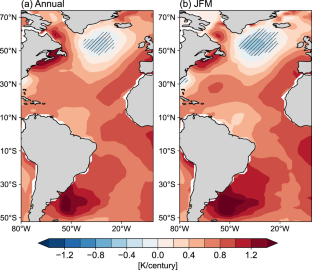2023-07-28 ペンシルベニア州立大学(PennState)
◆北大西洋振動(NAO)が関与しており、NAOの正の相が増加していることが冷却に寄与しています。これにより、海面温度が約0.7°F下がっています。研究者たちは、大気の変化による直接的な冷却効果があることを示し、冷たい塊の理解が将来の気候予測に重要であると強調しています。
◆ただし、海洋プロセスも冷却に影響を与えている可能性があり、両者を考慮する必要があると述べています。これにより、将来の高インパクト気象イベントや人口密集地域の気候予測の不確実性が増す可能性があるとしています。
<関連情報>
- https://www.psu.edu/news/research/story/north-atlantic-oscillation-contributes-cold-blob-atlantic-ocean/
- https://link.springer.com/article/10.1007/s00382-023-06847-y
北大西洋振動は過去100年の北大西洋低緯度部の冷却に寄与している North Atlantic Oscillation contributes to the subpolar North Atlantic cooling in the past century
Yifei Fan,Wei Liu,Pengfei Zhang,Ru Chen & Laifang Li
Climate Dynamics Published:12 June 2023
DOI:https://doi.org/10.1007/s00382-023-06847-y

Abstract
Sea surface temperature (SST) in the subpolar North Atlantic has significantly decreased at a rate of − 0.39 (±0.23) K/century during 1900–2020, which runs counter to global warming due to anthropogenic forcing. The cooling in the subpolar North Atlantic, known as the North Atlantic cold blob, could be driven by a host of mechanisms involving both the ocean and atmosphere. Here, we present evidence that changes in the atmospheric circulation over the North Atlantic, in particular a centennial trend towards a more positive phase of the North Atlantic Oscillation (NAO), could have contributed to the cold blob. The positive NAO intensifies the surface wind over the subpolar North Atlantic and induces excessive heat loss from the air-sea interface. According to an idealized mixed layer heat balance model, the NAO induced heat loss alone cools the subpolar North Atlantic by 0.26 K/century, which explains 67% of the observed cold blob SST trend. The NAO-induced cooling is partially offset by the warming effect from the East Atlantic Pattern, and the net effect of changes in atmospheric circulation explains 44% of the observed cooling trend. Thus, besides ocean circulation, including the slowdown of the Atlantic Meridional Overturning Circulation, the large-scale atmospheric circulation might have played an equally important role in prompting the century-long SST changes in the subpolar North Atlantic.



